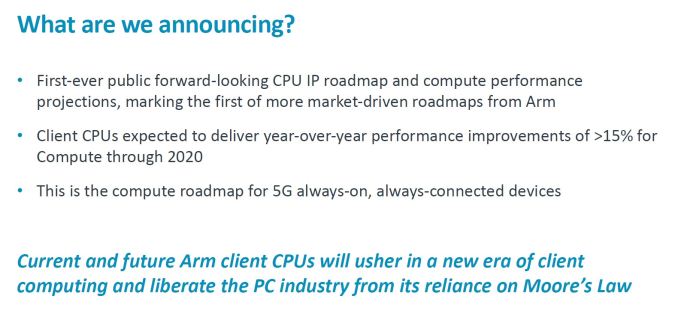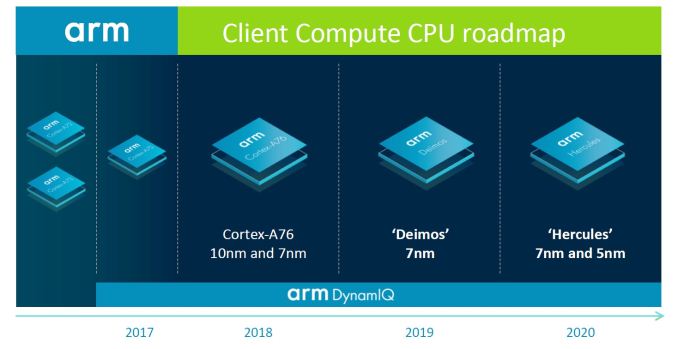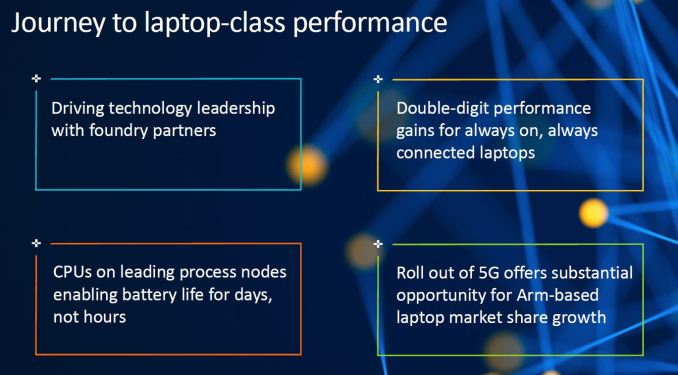Arm Unveils Client CPU Performance Roadmap Through 2020 - Taking Intel Head On
by Andrei Frumusanu on August 16, 2018 9:05 AM EST
Today’s announcement is an oddball one for Arm as we see the first-ever public forward looking CPU IP roadmap detailing performance and power projections for the next two generations through to 2020.
Back in May we extensively covered Arm’s next generation Cortex A76 CPU IP and how it’s meant to be a game-changer in terms of providing one of the biggest generational performance jumps in the company’s recent history. The narrative in particular focused on how the A76 now brought real competition and viable alternatives to the x86 market and in particular how it would be able to offer performance equivalent to Intel’s best mobile offerings, at much lower power.
Arm sees always-connected devices with 5G connectivity as a prime opportunity for a shift in the laptop market. Qualcomm’s recent Snapdragon 835 and Snapdragon 850 platforms were the first attempts in trying to establish this new slice for Arm-based PCs.
Today’s roadmap now publicly discloses the codenames of the next two generations of CPU cores following the A76 – Deimos and Hercules. Both future cores are based on the new A76 micro-architecture and will introduce respective evolutionary refinements and incremental updates for the Austin cores.
The A76 being a 2018 product – and we should be hearing more on the first commercial devices on 7nm towards the end of the year and coming months, Deimos is its 2019 successor aiming at more wide-spread 7nm adoption. Hercules is said to be the next iteration of the microarchitecture for 2020 products and the first 5nm implementations. This is as far as Arm is willing to project in the future for today’s disclosure, as the Sophia team is working on the next big microarchitecture push, which I suspect will be the successor to Hercules in 2021.
Part of today’s announcement is Arm’s reiteration of the performance and power goals of the A76 against competing platforms from Intel. The measurement metric today was the performance of a SPECint2006 Speed run under Linux while complied under GCC7. The power metrics represent the whole SoC “TDP”, meaning CPU, interconnect and memory controllers – essentially the active platform power much in a similar way we’ve been representing smartphone mobile power in recent mobile deep-dive articles.
Here a Cortex A76 based system running at up to 3GHz is said to match the single-thread performance of an Intel Core i5-7300U running at its maximum 3.5GHz turbo operating speed, all while doing it within a TDP of less than 5W, versus “15W” for the Intel system. I’m not too happy with the power presentation done here by Arm as we kind of have an apples-and-oranges comparison; the Arm estimates here are meant to represent actual power consumption under the single-threaded SPEC workload while the Intel figures are the official TDP figures of the SKU – which obviously don’t directly apply to this scenario.
We didn’t have internal data to verify Arm’s claims as of publishing of the article, but the 15W Intel figure is naturally on the high side, given that this just the official TDP representing multi-threaded workloads – a very quick test of CB15 ST power as reported by MSR registers on an 7200U at 3.1GHz measured 9.3W package+DRAM power while an 8250U at 3.35GHz came in at 11W. I haven’t correlated SPEC power on x86 to date, but I’m expecting it on average to be less than CB15. Even if the 15W figure for the 7300U is correct, and I’m expecting something more in the range of 9-11W, Arm might be using one of Intel’s notably less efficient performance points when doing the comparison for these SKUs. Of course this doesn’t invalidate the data as efficiency for the A76 at those frequencies would also not be optimal, it’s just something to keep in mind.
It’s also interesting to see Arm scale back on the performance comparison as they’re using a 3GHz A76 as the comparison data-point – this is in contrast to the 3.3GHz maximum 5W performance point presented during TechDay. I had tried to estimate the A76’s power in mobile form-factors based on the different metrics Arm disclosed and came at an estimated 2.3W at 3GHz. Naturally Arm says “less than 5W” and they could be erring on the safe side of not over-promising – but if it had been *that* much lower, as in my estimate, we would have maybe seen even more aggressive marketing figures. In the end, until we get the first A76 devices in our hands, we won’t know for sure what the exact figures will be and at which point on the efficiency curve Arm’s projected 3GHz performance figures will end up at.
The last slide that is notable to talk about is the performance projections for Deimos and Hercules. Here Arm’s taking a direct stab at Intel’s lack of significant progress over the last few years and reiterating its confidence in the company’s ability in sustaining high CAGR (compound annual growth rate) performance figures for the next generations.
Again at TechDay we quoted figures of 20-25% while today’s announcement contained a more conservative figures of “>=15%” – likely better representing a seemingly larger 20% projected boost for Deimos as well as what seems to be a 10% gain for the 5nm follow-up Hercules. Taking into account the relative positioning of the data-points in this chart, I did some quick correlation and it matches my initial estimated performance figures for a 3GHz A76 at around ~26 SPECint2006. Deimos and Hercules would come in at figures of ~31 and ~34 points.
Finally today’s announcement is a marketing exercise attempting to emphasise Arm’s performance and power commitments over the next few generations, trying to showcase it has the strategy and technology in place to make the Arm laptop market a real growth opportunity. If and how this pans out is something that we won’t find out at least until later on in the year, with the first actual A76 based large form-factor designs not being a thing until at least sometime in 2019. We’re eagerly awaiting the first A76 based mobile designs in the months to come and to have a first hand-on evaluation of the new microarchitecture family.















102 Comments
View All Comments
Wilco1 - Saturday, August 18, 2018 - link
If you mean the post by the guy who has an issue with SMT, then no, he has no clue. We're talking CPU performance, not SoC similarity - the key techniques to improve CPU performance are well known. There is no magic, if you're willing to invest lots of money, increase die area and design for higher power consumption, you can increase performance dramatically.maroon1 - Thursday, August 16, 2018 - link
LOL they are comparing it to last generation 7th gen i5 (and probably in benchmark that favor ARM CPU)The new i5 has more cores and threads.
Wilco1 - Thursday, August 16, 2018 - link
LOL This is a single threaded comparison...zodiacfml - Thursday, August 16, 2018 - link
Crippled by Windows. What is it like running Android in a laptop form factor? It seems a lot of productivity can be done with Android these days.I'd take an Arm laptop at the same price as an Intel Core i5. Arm has to remove the insane price premium.
Fritzkier - Friday, August 17, 2018 - link
I agree with this guy. ARM should've remove the price premium to compete.Well, considering ARM progressing more than Intel in the last decade, if Intel don't do anything, they'll be doomed.
sgeocla - Friday, August 17, 2018 - link
This is all fine and dandy for ARM and Intel but nobody mentions that the Ryzen 2700u with it's 12nm process is offering 4 cores/8 threads and 10 GPU cores at 15W. Next year that is going to move to 7nm and get a huge efficiency boost, probably going to 10W at the same performance level.Also, there are battery improvements every year. Sure, the new Windows on ARM laptops get 20+ hours of battery life, but can you really play the latest games or even have a lot of browser tabs opened without slowing performance to a crawl? Hell no.
By 2020 the battery capacity will increase and other components of the system will also consume less power but the PC user buying Windows on ARM devices will get 30 hours of battery life but still unable to play the latest games, and the OEMs support hotlines will still be plagued with calls about apps not working / emulating properly. Meanwhile AMD (and even Intel in 2020+ after they fix 10nm) powered laptops will still get 15+ hours of battery life and all the benefits.
MS already learned their lesson so the new Surface Go is still x86 and not ARM.
And Qualcomm is already in a partnership with AMD to get its modems into Ryzen mobile chips because compatibility is still the largest perk of x86.
Yojimbo - Friday, August 17, 2018 - link
I wonder if Sony or Microsoft would consider putting out an ARM-based console for their next generation. These laptop-grade CPUs might be perfect for that. I also wonder if Intel's discrete GPU would be in a position to vie for the next gen console contracts. It could get interesting.A5 - Friday, August 17, 2018 - link
Depends on when R&D work started. If, say, PS5 is already deep in the pipeline it is probably a Zen+Vega design.dromoxen - Friday, August 17, 2018 - link
At this point in time , x86 is the most efficient steam train on the market But surely intel has been cooking up something the labs to replace it, smeltdown and all other attacks just hasten its demise. it CAN be done , and will be a necessity beyond 5nm.milkod2001 - Friday, August 17, 2018 - link
Love this ARM on Windows laptops initiatives but on the end of day if they price them same as Intel laptops i really don't see point with it. Why to bother with something what is not 100% compatible with Windows apps if price is the same.Either significantly lower the price of just don't bother.